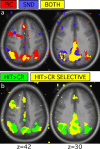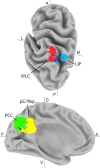Functional-anatomic correlates of memory retrieval that suggest nontraditional processing roles for multiple distinct regions within posterior parietal cortex - PubMed (original) (raw)
Functional-anatomic correlates of memory retrieval that suggest nontraditional processing roles for multiple distinct regions within posterior parietal cortex
Benjamin J Shannon et al. J Neurosci. 2004.
Abstract
Current theories of posterior parietal cortex (PPC) function emphasize space-based attention and motor intention. Imaging studies of long-term memory have demonstrated PPC activation during successful memory retrieval. Here, we explored the relationship between memory processes and classical notions of PPC function. Study 1 investigated old-new recognition using picture and sound stimuli to test whether PPC memory effects were dependent on visuospatial attention. A region lateral to the intraparietal sulcus [inferior parietal lobule complex (IPLC)] and two regions in the medial PPC [precuneus complex (PCC) and posterior cingulate/retrosplenial cortex (pC/Rsp)] showed strong retrieval success effects for both picture and sound stimuli. Study 2 explored a recognition task with varied response contingencies to investigate whether these retrieval success effects are dependent on motor intentions. In one condition, subjects responded to both old and new items. In two other conditions, subjects responded only to old or only to new items. IPLC, PCC, and pC/Rsp continued to show retrieval success effects with similar magnitudes for all response contingencies, including a condition in which no responses were made to old items. In a third study, IPLC and PCC activity was modulated at retrieval based on levels of processing at study, suggesting sensitivity to memory demands. These studies demonstrate that retrieval success effects in lateral and medial PPC regions are not affected by manipulations predicted by classical theories of PPC function but can be modulated by memory-related manipulations. PPC regions thus have prominent response properties associated with memory, which may arise through interactions with medial temporal cortex.
Figures
Figure 1.
Behavioral results for study 1. a, Corrected recognition performance: the percentage of incorrectly identified new items (FA) was subtracted from the percentage of correctly identified old items (HIT) to evaluate performance for each modality. b, Response time. Mean response times for HIT and CR trial types are shown for each modality. For all figures, error bars represent SEM.
Figure 2.
Conjunctions of whole-brain activation maps reveal regions associated with retrieval success. a, Conjunction maps generated from HIT>CR for pictures and HIT>CR for sounds reveal regions showing retrieval success effects for pictures (red), sounds (blue), and both (yellow). b, Conjunction maps generated from HIT>CR and PIC>SND (CR trials only) contrasts show regions that exhibit retrieval success effects with (HIT>CR; green) and without (HIT>CR SELECTIVE; yellow) effects of modality. For all maps, images represent transverse sections with the approximate level taken from the atlas of Talairach and Tournoux (1988). The left hemisphere is displayed on the left. The anatomic backdrop represents the average anatomic image from the subjects included in the study.
Figure 3.
Anatomical location of parietal regions relative to landmarks. Medial (M) and lateral (L) views of PPC show regions IPLC (red), PCC (green), and pC/Rsp (yellow) along with estimates of LIP (blue; based on the study by Sereno et al., 2001) [a spherical region was generated about a peak coordinate exactly contralateral to a reported peak (-32, -68, 46)]. Images were created using Caret software (Van Essen et al., 2001; Van Essen, 2002). A, Anterior; P, posterior; D, dorsal; V, ventral.
Figure 4.
PPC retrieval success effects occur for both picture and sound stimuli. Regional analyses were conducted for IPLC, PCC, and an extrastriate visual region as a control (VIS CTRL). The difference in signal change between correctly identified old (HIT) and new (CR) items is plotted for PIC and SND items for each region. Inferential statistics are not presented forth is experiment, because IPLC and PCC were defined based on data from this experiment (Fig. 2_b_).
Figure 5.
Behavioral results for study 2. a, Corrected recognition performance. b, Response time. Mean response times for HIT and CR trial types are shown for each trial type that required a response. c, The proportion of items identified by subjects as old in each condition. O/N, Response Old/New condition.
Figure 6.
PPC retrieval success effects are independent of response contingencies. Regional analyses were conducted for IPLC, PCC, and a motor region as a control (MTR CTRL). The difference in signal change between correctly identified old (HIT) and new (CR) items is plotted for Respond Old/New (O/N), Respond Old (O), and Respond New (N) conditions for each region. IPLC and PCC showed retrieval success effects for all conditions; motor cortex was more active when responses were made, but did not modulate based on the mnemonic status of an item. For all inferential comparisons, asterisks and bars represent different levels of significance: *p < 0.05; **p < 0.01; ***p < 0.001.
Figure 7.
Conjunctions of whole-brain activation maps reveal PPC regions showing retrieval success effects for all response contingencies. Note the similarity between these regions and those shown in Figure 2.
Figure 8.
Behavioral results for study 3. a, Corrected recognition performance. b, Response time. Mean response times are shown for each trial type [DH, HIT following deep study (DEEP); SH, HIT following shallow study(SHAL)].
Figure 9.
PPC retrieval success effects are influenced by retrieval demands. Regional analyses were conducted for IPLC and PCC. The difference in signal change between correctly recognized old items following deep study (DEEP), following shallow study (SHAL), and correctly rejected new items (CR) is plotted for each region. Both IPLC and PCC showed significant HIT>CR effects, the magnitudes of which were significantly modulated at retrieval dependent on levels of processing at encoding.
Figure 10.
Whole-brain activation maps reveal PPC regions modulating by retrieval demands. Maps show voxels that demonstrate significantly greater activity for deeply studied HIT items versus shallowly studied HIT items.
Similar articles
- Functional heterogeneity in posterior parietal cortex across attention and episodic memory retrieval.
Hutchinson JB, Uncapher MR, Weiner KS, Bressler DW, Silver MA, Preston AR, Wagner AD. Hutchinson JB, et al. Cereb Cortex. 2014 Jan;24(1):49-66. doi: 10.1093/cercor/bhs278. Epub 2012 Sep 26. Cereb Cortex. 2014. PMID: 23019246 Free PMC article. - Parietal lobe contributions to episodic memory retrieval.
Wagner AD, Shannon BJ, Kahn I, Buckner RL. Wagner AD, et al. Trends Cogn Sci. 2005 Sep;9(9):445-53. doi: 10.1016/j.tics.2005.07.001. Trends Cogn Sci. 2005. PMID: 16054861 Review. - Dissociable parietal regions facilitate successful retrieval of recently learned and personally familiar information.
Elman JA, Cohn-Sheehy BI, Shimamura AP. Elman JA, et al. Neuropsychologia. 2013 Mar;51(4):573-83. doi: 10.1016/j.neuropsychologia.2012.12.013. Epub 2012 Dec 31. Neuropsychologia. 2013. PMID: 23287568 - Top-down and bottom-up attention to memory: a hypothesis (AtoM) on the role of the posterior parietal cortex in memory retrieval.
Ciaramelli E, Grady CL, Moscovitch M. Ciaramelli E, et al. Neuropsychologia. 2008;46(7):1828-51. doi: 10.1016/j.neuropsychologia.2008.03.022. Epub 2008 Apr 8. Neuropsychologia. 2008. PMID: 18471837 Review. - Functional anatomic studies of memory retrieval for auditory words and visual pictures.
Buckner RL, Raichle ME, Miezin FM, Petersen SE. Buckner RL, et al. J Neurosci. 1996 Oct 1;16(19):6219-35. doi: 10.1523/JNEUROSCI.16-19-06219.1996. J Neurosci. 1996. PMID: 8815903 Free PMC article.
Cited by
- Posterior Cingulate and Lateral Parietal Gray Matter Volume in Older Adults with Depressive Symptoms.
Ries ML, Wichmann A, Bendlin BB, Johnson SC. Ries ML, et al. Brain Imaging Behav. 2009 Sep;3(3):233-239. doi: 10.1007/s11682-009-9065-4. Epub 2009 Apr 15. Brain Imaging Behav. 2009. PMID: 19701486 Free PMC article. - Brain correlates of mathematical competence in processing mathematical representations.
Grabner RH, Reishofer G, Koschutnig K, Ebner F. Grabner RH, et al. Front Hum Neurosci. 2011 Nov 4;5:130. doi: 10.3389/fnhum.2011.00130. eCollection 2011. Front Hum Neurosci. 2011. PMID: 22069387 Free PMC article. - Transdiagnostic commonalities and differences in resting state functional connectivity of the default mode network in schizophrenia and major depression.
Schilbach L, Hoffstaedter F, Müller V, Cieslik EC, Goya-Maldonado R, Trost S, Sorg C, Riedl V, Jardri R, Sommer I, Kogler L, Derntl B, Gruber O, Eickhoff SB. Schilbach L, et al. Neuroimage Clin. 2015 Dec 2;10:326-35. doi: 10.1016/j.nicl.2015.11.021. eCollection 2016. Neuroimage Clin. 2015. PMID: 26904405 Free PMC article. - Functional neuroimaging correlates of finger-tapping task variations: an ALE meta-analysis.
Witt ST, Laird AR, Meyerand ME. Witt ST, et al. Neuroimage. 2008 Aug 1;42(1):343-56. doi: 10.1016/j.neuroimage.2008.04.025. Epub 2008 Apr 16. Neuroimage. 2008. PMID: 18511305 Free PMC article. - Activation and effective connectivity changes following explicit-memory training for face-name pairs in patients with mild cognitive impairment: a pilot study.
Hampstead BM, Stringer AY, Stilla RF, Deshpande G, Hu X, Moore AB, Sathian K. Hampstead BM, et al. Neurorehabil Neural Repair. 2011 Mar-Apr;25(3):210-22. doi: 10.1177/1545968310382424. Epub 2010 Oct 9. Neurorehabil Neural Repair. 2011. PMID: 20935339 Free PMC article.
References
- Althoff RR, Cohen NJ (1999) Eye-movement-based memory effect: a reprocessing effect in face perception. J Exp Psychol Learn Mem Cogn 25: 997-1010. - PubMed
- Andersen RA, Buneo CA (2002) Intentional maps in posterior parietal cortex. Annu Rev Neurosci 25: 189-220. - PubMed
- Andersen RA, Asanuma C, Essick G, Siegel RM (1990) Corticocortical connections of anatomically and physiologically defined subdivisions within the inferior parietal lobule. J Comp Neurol 296: 65-113. - PubMed
- Baker JT, Sanders AL, Maccotta L, Buckner RL (2001) Neural correlates of verbal memory encoding during semantic and structural processing tasks. NeuroReport 12: 1251-1256. - PubMed
Publication types
MeSH terms
LinkOut - more resources
Full Text Sources









